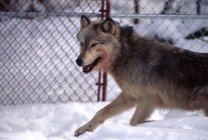3:41 AM -  Animal Facts
Animal Facts
 No comments
No comments
 Animal Facts
Animal Facts
 No comments
No comments
11 Facts About A Wolf
 Fun Wolf Facts
Fun Wolf Facts Living and hunting in packs, wolves are wild dogs that come from the same group as the dingo and coyote.
They can reach speeds of 65 km/h (40 mph) when chasing prey and include a number of species such as the gray wolf (also known as the grey wolf or timber wolf), red wolf, arctic wolf, mexican wolf and white wolf. Read on for more interesting information and enjoy our full list of wolf facts.
- Wolves are excellent hunters and have been found to be living in more places in the world than any other mammal except humans.
- The wolf is the ancestor of all breeds of domestic dog. It is part of a group of animals called the wild dogs which also includes the dingo and the coyote.
- Most wolves weigh about 40 kilograms but the heaviest wolf ever recorded weighed over 80 kilograms!
- Adult wolves have large feet. A fully grown wolf would have a paw print nearly 13 centimetres long and 10 centimetres wide.
- Wolves live and hunt in groups called a pack. A pack can range from two wolves to as many as 20 wolves depending on such factors as habitat and food supply. Most packs have one breeding pair of wolves, called the alpha pair, who lead the hunt.
- Wolf pups are born deaf and blind while weighing around 0.5 kg (1 lb). It takes about 8 months before they are old enough to actively join in wolf pack hunts.
- Wolves in the Arctic have to travel much longer distances than wolves in the forest to find food and will sometimes go for several days without eating.
- When hunting alone, the wolf catches small animals such as squirrels, hares, chipmunks, raccoons or rabbits. However, a pack of wolves can hunt very large animals like moose, caribou and yaks.
- When the pack kills an animal, the alpha pair always eats first. As food supply is often irregular for wolves, they will eat up to 1/5th of their own body weight at a time to make up for days of missed food.
- Wolves have two layers of fur, an undercoat and a top coat, which allow them to survive in temperatures as low at minus 40 degrees Celsius! In warmer weather they flatten their fur to keep cool.

0 comments:
Post a Comment